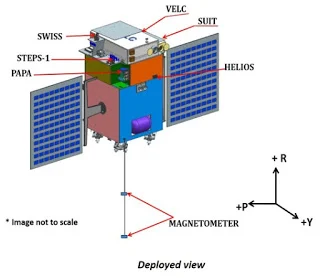India’s first solar mission Aditya-L1 to unravel many mysteries
Aditya - L1 First Indian mission to study the Sun
Aditya आदित्य.
The most ambitious space missions undertaken by the space agency.
The Aditya-1 mission was conceived as a small 400 kg class satellite carrying one payload, the Visible Emission Line Coronagraph (VELC) and was planned to launch in a 800 km low earth orbit. A Satellite placed in the halo orbit around the Lagrangian point 1 (L1) of the Sun-Earth system has the major advantage of continuously viewing the Sun without any occultation/ eclipses. Therefore, the Aditya-1 mission has now been revised to “Aditya-L1 mission” and will be inserted in a halo orbit around the L1, which is 1.5 million km from the Earth. The satellite carries additional six payloads with enhanced science scope and objectives.
The project is approved and the satellite will be launched during 2021 – 2022 timeframe by Polar Satellite Launch Vehicle PSLV in XL from Sriharikota.
Aditya-1 was meant to observe only the solar corona. The outer layers of the Sun, extending to thousands of km above the disc (photosphere) is termed as the corona. It has a temperature of more than a million degree Kelvin which is much higher than the solar disc temperature of around 6000K. How the corona gets heated to such high temperatures is still an unanswered question in solar physics.
PSLV-C49 to launch EOS-01 and nine customer satellites on November 07, 2020
ISRO mangalyaan has discover the red planet is losing its air to space
Top 10 biggest achievements of ISRO
Aditya-L1 with additional experiments can now provide observations of Sun's Corona (soft and hard X-ray, Emission lines in the visible and NIR), Chromosphere (UV) and photosphere (broadband filters). In addition, particle payloads will study the particle flux emanating from the Sun and reaching the L1 orbit, and the magnetometer payload will measure the variation in magnetic field strength at the halo orbit around L1. These payloads have to be placed outside the interference from the Earth’s magnetic field and could not have been useful in the low earth orbit.
The main payload continues to be the coronagraph with improved capabilities. The main optics for this experiment remains the same. However, many instruments to be used in the mission are being manufactured indigenously which makes the task complicated. Some moving instruments are also being used on the mission.
Payloads
- Visible Emission Line Coronagraph (VELC): To study the diagnostic parameters of solar corona and dynamics and origin of Coronal Mass Ejections (3 visible and 1 Infra-Red channels); magnetic field measurement of solar corona down to tens of Gauss – Indian Institute of Astrophysics (IIA)
- Solar Ultraviolet Imaging Telescope (SUIT): To image the spatially resolved Solar Photosphere and Chromosphere in near Ultraviolet (200-400 nm) and measure solar irradiance variations - Inter-University Centre for Astronomy & Astrophysics (IUCAA)
- Aditya Solar wind Particle Experiment (ASPEX) : To study the variation of solar wind properties as well as its distribution and spectral characteristics – Physical Research Laboratory (PRL)
- Plasma Analyser Package for Aditya (PAPA) : To understand the composition of solar wind and its energy distribution – Space Physics Laboratory (SPL), VSSC
- Solar Low Energy X-ray Spectrometer (SoLEXS) : To monitor the X-ray flares for studying the heating mechanism of the solar corona – ISRO Satellite Centre (ISAC)
- High Energy L1 Orbiting X-ray Spectrometer (HEL1OS): To observe the dynamic events in the solar corona and provide an estimate of the energy used to accelerate the particles during the eruptive events - ISRO Satellite Centre (ISAC)and Udaipur Solar Observatory (USO), PRL
- Magnetometer: To measure the magnitude and nature of the Interplanetary Magnetic Field – Laboratory for Electro-optic Systems (LEOS) and ISAC.
- With the inclusion of multiple payloads, this project also provides an opportunity to solar scientists from multiple institutions within the country to participate in space based instrumentation and observations. Thus the enhanced Aditya-L1 project will enable a comprehensive understanding of the dynamical processes of the sun and address some of the outstanding problems in solar physics.
Aditya l1 launch date
The Indian Space Research Organisation (ISRO) is planning to launch its maiden mission to study the magnificent Sun by the end of 2021.
The spacecraft will travel a long journey of 1.5 million km from the Earth for this task. ISRO has selected L1, or Lagrangian point 1, between the Earth and the Sun to place the satellite. This is a halo orbit, where the satellite can easily examine the Sun without any obstruction of celestial events like occultation or eclipses. Moreover, this parking slot has also been selected because the gravitational pull from the two celestial objects will become equal on the satellite, which would help balance it in the orbit.
For this mission, the space agency has selected six scientific payloads to study our galactic star. The main payload of the mission is the coronagraph, an instrument used to study different layers of the Sun like the photosphere, the chromosphere, and the corona, where the temperature shoots up to 5726.85 degrees Celsius!
Aditya l1 launch vehicle
It is planned to be launched on the PSLV-C56 in December 2021 or January 2022.





Comments